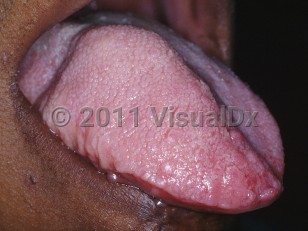Hemihyperplasia
Alerts and Notices
Important News & Links
Synopsis

Hemihypertrophy (hemihyperplasia) is a genetic condition where one side or part of one side of the body is larger compared with the other side. Tissues connected to the area of overgrowth may also be affected. In some cases, hemihypertrophy is obvious when the patient's posture and gait are affected. Patients may develop scoliosis. May occur as a feature of a genetic disorder, including Beckwith-Wiedemann syndrome, neurofibromatosis, Proteus syndrome, and Klippel-Trenaunay-Weber syndrome. Isolated hemihypertrophy incidence is estimated to be 1 in 86 000. The severity of the asymmetry varies.
Hemihypertrophy is usually diagnosed at birth or in childhood depending on patient's growth pattern. Diagnosis is essential, as idiopathic hemihypertrophy is associated with a heightened risk for developing embryonal tumors in childhood (most commonly Wilms tumor and hepatoblastoma).
Treatment is aimed at handling functional and cosmetic issues. Surgery is usually reserved for patients with length discrepancies over 4 cm and consists of shortening or lengthening the affected area(s). Nonsurgical orthopedic treatment options such as corrective shoe lifts are available.
Hemihypertrophy is usually diagnosed at birth or in childhood depending on patient's growth pattern. Diagnosis is essential, as idiopathic hemihypertrophy is associated with a heightened risk for developing embryonal tumors in childhood (most commonly Wilms tumor and hepatoblastoma).
Treatment is aimed at handling functional and cosmetic issues. Surgery is usually reserved for patients with length discrepancies over 4 cm and consists of shortening or lengthening the affected area(s). Nonsurgical orthopedic treatment options such as corrective shoe lifts are available.
Codes
ICD10CM:
Q87.2 – Congenital malformation syndromes predominantly involving limbs
SNOMEDCT:
123750006 – Asymmetric hypertrophy
Q87.2 – Congenital malformation syndromes predominantly involving limbs
SNOMEDCT:
123750006 – Asymmetric hypertrophy
Best Tests
Subscription Required
References
Subscription Required
Last Updated:01/17/2016

